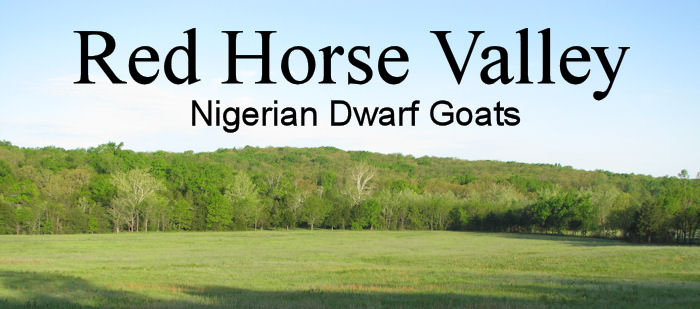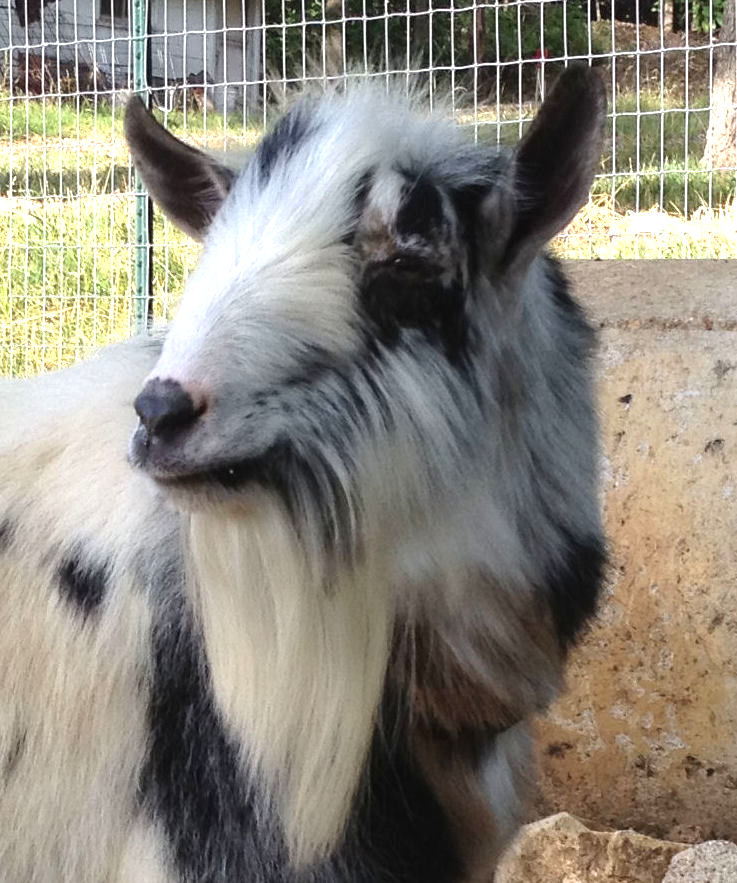
A Buck's Life
This is a true story of a difficult journey for our buck, Rosasharn BB Cento +*B, and myself. It all began when he was under a year of age. An accident, unseen, had left our little guy injured. My best guess at what happened was that he got his nylon collar caught on twisted fencing wire holding 2 by 4 field fence to a cattle panel to keep the little guy from crawling through the panel. He must have thrashed about to free himself, unfortunately injuring his neck in the process. He proceeded to do very well, maintaining his appetite and growing. However, the injury took its time healing. Just when the wound finally closed, it would open up and drain again.
We took him to our veterinarian who probed the wound, and x-rayed it with a probe in the tract. As suggested, we kept him on antibiotics for an extended period of time to allow him to heal. Just prior to our move from California to Missouri, during our herd health inspection for health certificates, we noticed grass in the wound of our boy. The very observant Michael Clark, DVM noted that the grass was coming out of the wound, not traveling into it. We got him into surgery just prior to our departure to try to seal the esophagus which must have been damaged months earlier. Unfortunately, due to the location of the fistula it wasn't observed from the inside. The wound was chemically cauterized from the outside, and Cento was placed on a restricted diet to allow his esophagus to heal as best as it could.
The fistula failed to heal. We flushed it with water daily, and the external wound closed. All seemed to be okay, until months later I found Cento had a massive neck, hidden in his winter coat, filled with nastiness and he was nearing death's door. This was the week prior to Christmas, 2011. Our local veterinarian referred us to the University of Missouri - Columbia Veterinary Teaching Hospital. Was this to be a Christmas miracle? Only time would tell.
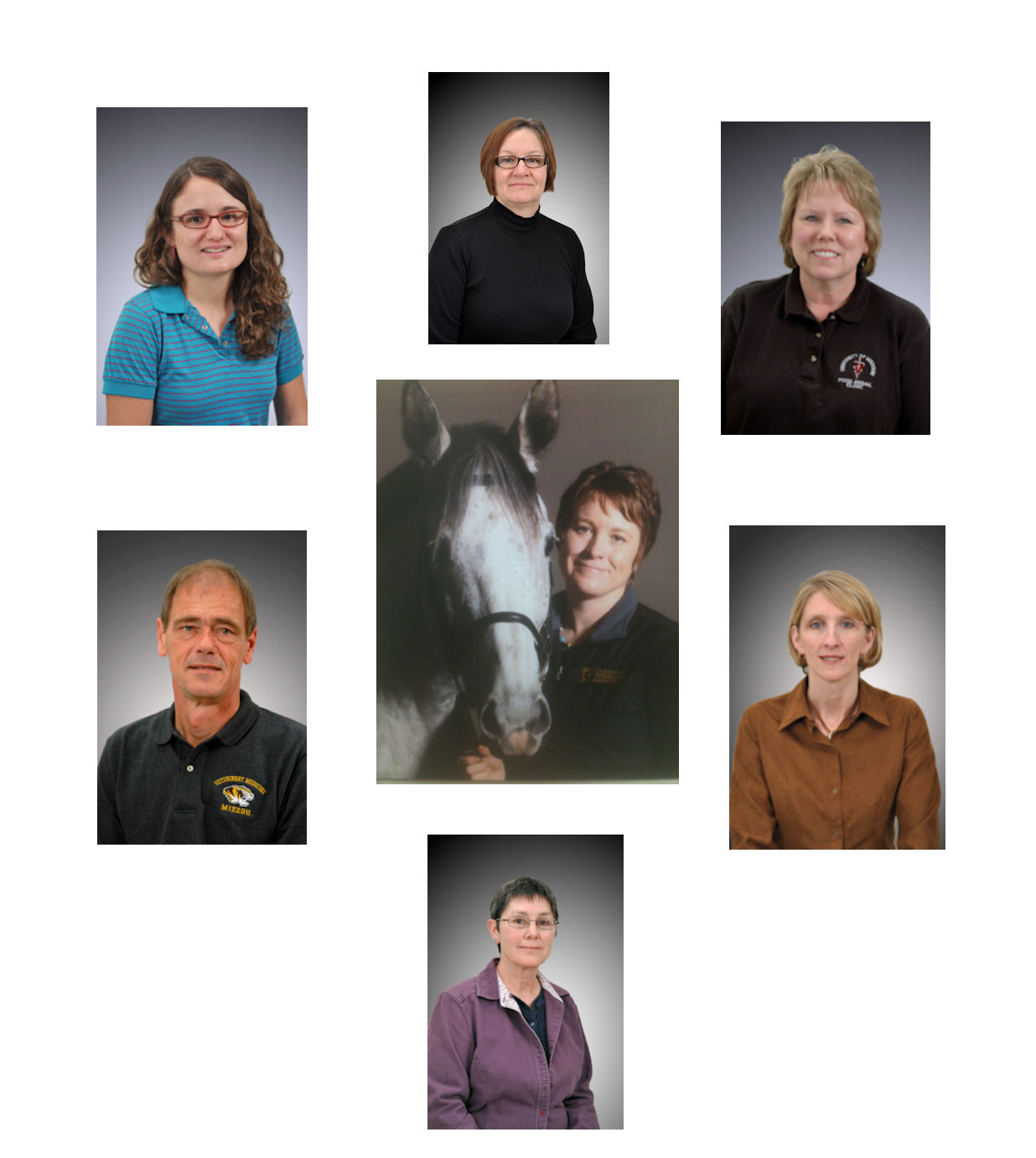 Left to right: Pamela Fry, DVM, Flo Nelson, Julie Holle; Dr. Dietrich Volkmann, Shannon Reed, DVM, Dawna Voelkl, DVM; Karen Siegler; Not shown: John R Middleton, DVM, PhD, Meera Heller, DVM, Becky Bravo, and Ignacio Idoate, DVM
Left to right: Pamela Fry, DVM, Flo Nelson, Julie Holle; Dr. Dietrich Volkmann, Shannon Reed, DVM, Dawna Voelkl, DVM; Karen Siegler; Not shown: John R Middleton, DVM, PhD, Meera Heller, DVM, Becky Bravo, and Ignacio Idoate, DVM
December 20, 2011 I drove Cento 90 miles to Columbia to see what could be done for him. John R. Middleton, DVM, PhD evaluated him and expertly assembled a team of professionals to consult on my behalf. Enter equine surgeon Shannon Reed, DVM for her unbelievable talent to assess his injury and plan for possible treatment options. "Ultrasound revealed that the mass was fluid filled with multiple communicating pockets. At the time of ultrasound, no air was present in the mass. The jugular veins and carotid arteries are intimately involved with the mass. The overall diameter of the fluid/mass is approximately 10 cm. The trachea is compressed by the mass and difficult to visualize with the ultrasound." Dr. Reed's report continues, "The diagnosis is chronic esophageal fistula with associated infection of the tissues of the neck. This is a very serious issue and is complicated by the structures involved, the structures nearly, and the chronicity of the problem. Resolution of the fistula requires inducing healing of the defect (which is currently static), allowing the defect to rest during this healing process, and resolving the significant infection in the tissues of the neck. To that end, and after deliberation, I would offer the following plan for treatment (while recommending a serious consideration of euthanasia as an option due to the extensive nature of the issue and associated high cost of treatment):..." I had to be prepared for the worst - the loss of Cento, the loss of money to treat him, and/or the possibility of a permanently sterile buck. The cost of surgery, not including rumenotomy reversal and no complications was estimated between $2500 and $3500. Not to mention the home nursing care that would be required for many weeks, and return visits that would be required, the decision was a serious commitment of time and money with no guarantees of anything in return. On the other hand, if I decided to proceed with euthanasia, I would have to be prepared to live the decision to not attempt treatment.
I wondered if we could possibly have him collected prior to the surgery to have backup insurance in case the worst should happen. Enter Dawna Voelkl, DVM and Dr. Dietrich Volkmann for a breeding soundness exam. Remember, this is all happening on Dec 20th - right before the Christmas break - and Dr Middleton is gathering specialists at seemingly a moments notice of my questions. Alas, while Cento did have some live sperm, the quality was too low to have a good freeze and recovery. Earlier in June, I had purchased a doeling, sired by Cento's littermate, Rosasharn BB Tom Bombadil *B, for Cento to breed in hopes of producing a nice buckling in case Cento's life was shortened due to his chronic injury. Was it possible that he could breed her (or that she could be artificially inseminated with fresh semen) prior to his surgery?
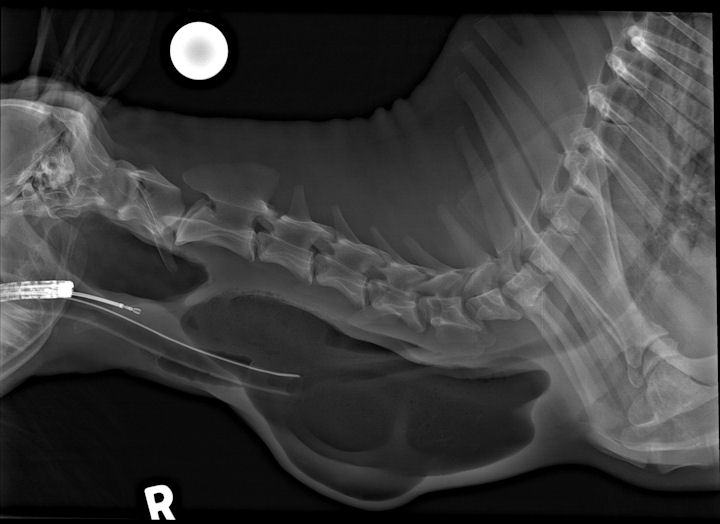
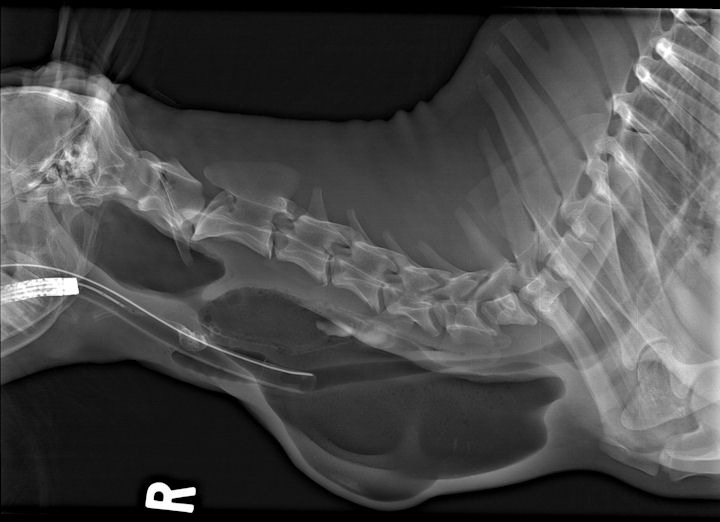
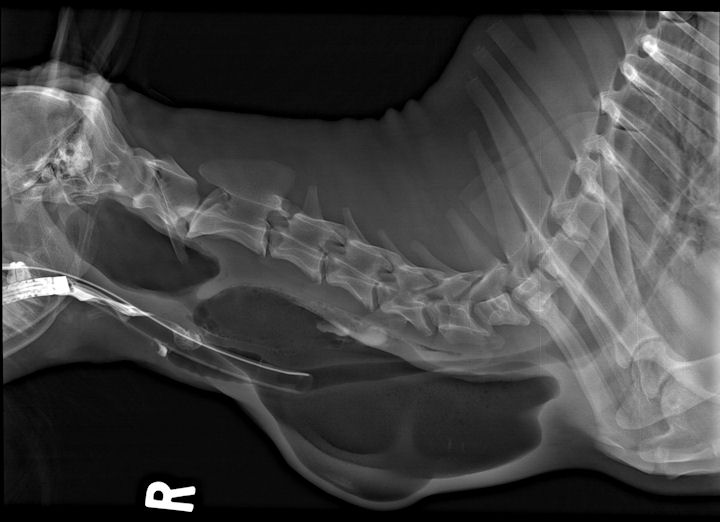
The decision was made to take Cento home, induce estrus in my doe, and hope that he could either breed her or bring them both back for artificial insemination on Friday, 12/23/11. Cento would then be left at the hospital to undergo his surgery on Tuesday, 12/27/2011. Fluid in the mass on his neck was removed so that he could breathe better, and he was placed on antibiotics. The following day, Wednesday, 12/21/2011, I found two of my does in season. I wasn't sure Cento would feel up to servicing them, but I thought I would see if he was interested. Indeed, he serviced one after the other... good boy! As it turned out, he settled Goldie who delivered 2 doelings on 5/15/2012, however Bea didn't settle. By Thursday 12/22, Cento didn't feel quite so well as he was crying with what appeared to be pain in his head. I gave him some banamine, and worried incessantly about the welfare of my dear little buck. Friday came, and Lizzie stood for Cento, so artificial insemination wasn't necessary. We had an appointment with Dr Reed at 2 pm, and I was very concerned about Cento having to wait all the way until Tuesday for surgery. Upon evaluation, and removal of more fluid/bacteria from the mass on his neck, we agreed to proceed as planned and that immediate surgery wasn't necessary.
On Tuesday, 12/27/2011, Lizzie came back into estrus. Unfortunately it seemed that she didn't ovulate with the estrus on the previous Friday. Time would confirm that Lizzie hadn't settled. Cento's surgery was pushed back to Wednesday 12/28/2011 in order to have a fresh team start work on him at ~10 AM. A rumenotomy was performed so that his esophagus could rest after laser treatment to initiate healing of the fistula. His esophagus had adhered to his neck muscles. All feeding would be done directly into his rumen for several weeks. 500 cc of fluid/bacteria was drained from his neck. He had a large incision on his neck which needed to be flushed several times a day and rebandaged. He had to be kept without bedding so that he wouldn't eat it. Cento was to remain at VMTH until 1/5/2012. By that time, I was barely prepared to see how thin my boy had become, but at least he had survived! It was indeed a Christmas miracle for me, delivered by the blessed hands of Shannon Reed, DVM and her spectacular team!
Endoscopy and laser treatment 1/3/2012.
Endoscopy and laser touch-up 1/12/2012.
My work with Cento was just beginning. He needed to be fed through his rumenotomy four(!) times a day. It sounds easy enough, however when you realize that the rumen contracts normally 1-4 times per minute, and that I am pouring food into a hole in this contracting bag.... well, you can possibly envision the challenge (and mess) this actually is! Cento's entire diet, food and water, had to be delivered directly into his rumen, and somehow he needed to keep it inside that rumen and not push it all out the hole in his side (and all over his left side, his crate, or the floor). He wasn't allowed anything by mouth, however he felt he was starving (he had lost a large percentage of his body weight) so he wanted to eat anything he could get hold of.
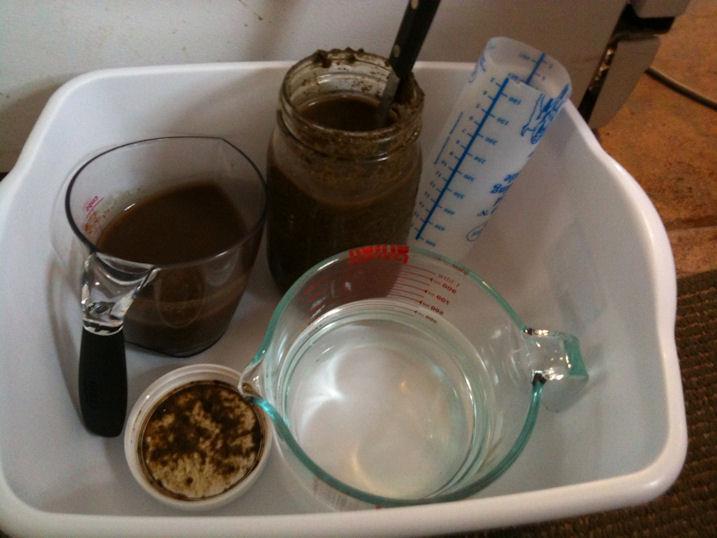 Feeding Supplies
Feeding Supplies
Healing was a slow process, fraught with infection, nutritional crisis, parasite burden, additional surgical procedures and just plain hard work for myself monitoring his weight, temperature, feeding, medications, and cleaning of both Cento as well as his indoor accommodations including doing his daily laundry. A positive outcome was still far from certain. Through all of this, Cento was a fabulous patient, tolerating my fussing with him even when it hurt, and learning how to live life without his herd. I am so very thankful that he made my job enjoyable and not dreadful with all I had decided to put him through.
Our boy Cento was not the only one who received fabulous care during our ordeal from the Veterinary Medical Teaching Hospital at the University of Missouri - Columbia. The humans are also very well cared for as well! I will never forget the image of Cento standing in a deep straw bedded manger right before Christmas with delicious hay presented to him with a flourish by Ignacio Idoate, DVM prior to his life-saving surgery. It was obvious he was in good hands, and that he was going to be cared for lovingly by the veterinary team and students. I briefly thought about snapping a picture as it was a beautiful sight, however with a positive outcome being far from certain, I couldn't bear to risk having that memory documented and lasting.
In addition, I received daily updates from Becky Bravo, VMTH student, before and after his surgery. Becky remained available to me via email, and encouraged me to email and/or call with updates or questions. She even continued to keep in touch with me after her rotation with Cento was over, answering questions and giving me encouragement through the lengthy recovery phase. Her genuine concern for his welfare was quite evident, and it was very comforting for me to know that I wasn't alone and that she along with others were available to help support me however they could.
Final endoscopy check for fistula closure.
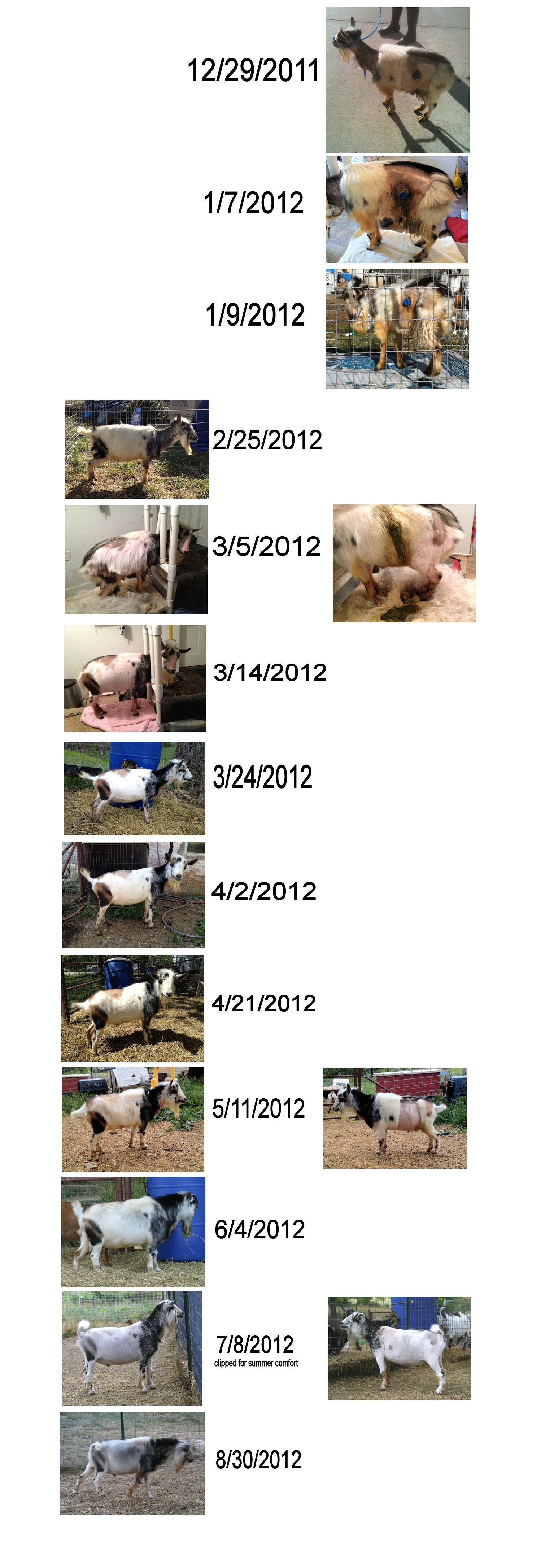 Post surgical progress
Post surgical progress
Cento's recovery process was lengthy indeed. His weight dropped to just over 30 pounds at the lowest point, and had sub-normal temperatures. He was kept crated indoors wearing a "goat coat", in addition to having a space heater near his crate. Getting sufficient food into his rumen so he could maintain weight was challenging. We switched his diet to a combination of Purina X-Clamation Show Goat mixed with alfalfa pellets, soaked into a mash and delivered directly to his rumen several times a day. After a couple weeks, I increased the amount fed to nearly 700 g a day, or as close to that amount as I could get with the losses coming back out his side. It seemed like ages passed before he finally started to gain back some of his lost weight, but on 1/25/2012 he weighed in at 36 pounds, still emaciated but at least the trend was finally proceeding in the right direction.
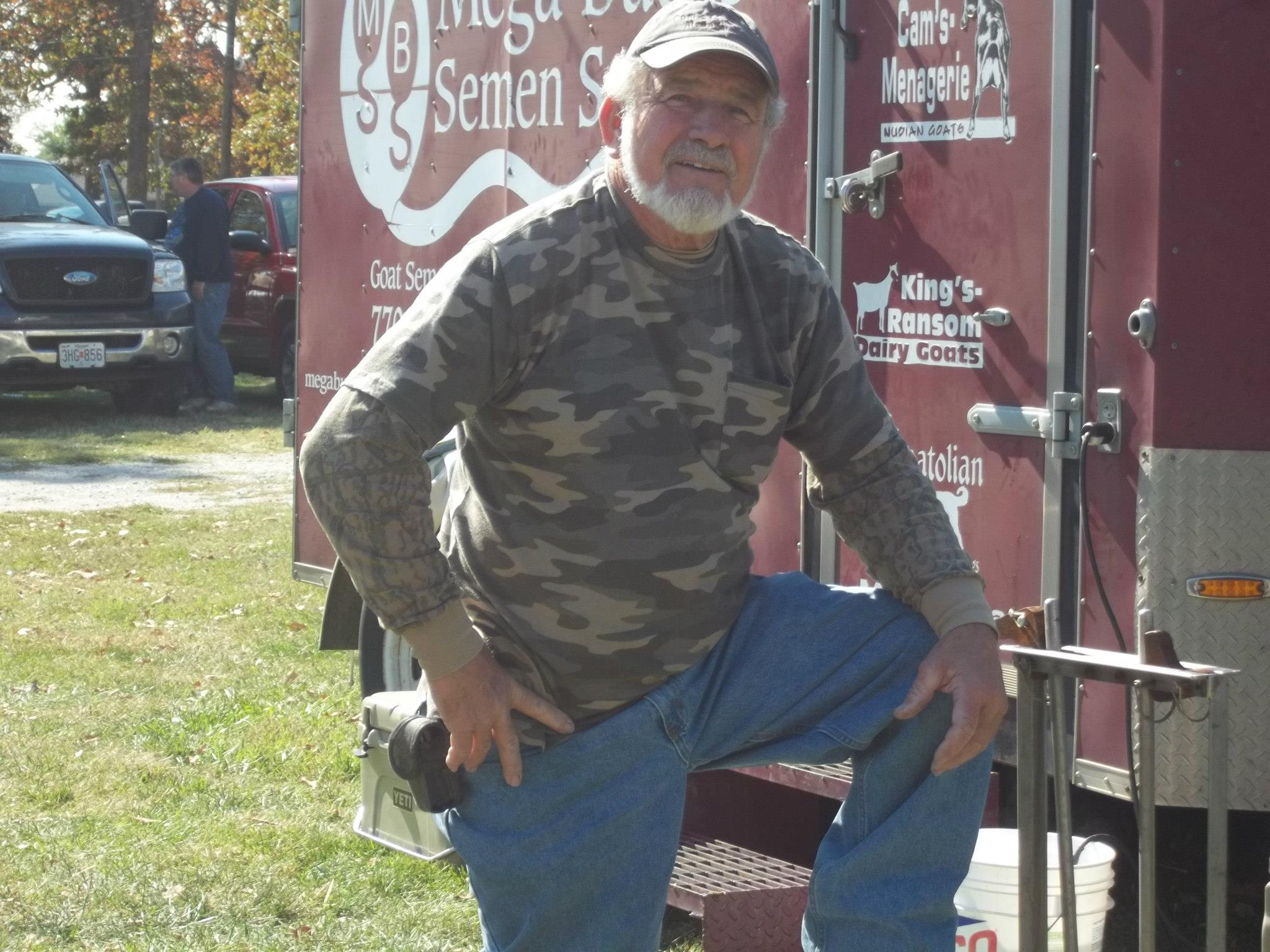 Cam Faircloth - SMDGA 2012 Fall Frenzy Quad Buck show - photo courtesy Matthew Dalzell
Cam Faircloth - SMDGA 2012 Fall Frenzy Quad Buck show - photo courtesy Matthew Dalzell
We were fortunate enough to have Cam Faircloth visit our farm in October of 2012 just prior to his scheduled collection at the Southwest Missouri Dairy Goat Association's Fall Frenzy Quad Buck show in Neosho, MO. I had semen collected from all of my bucks. I was hopeful that Cento's semen would be found healthy enough to freeze, and survive the freeze/thaw process, but I wasn't sure I would be so lucky. Thankfully, Cam showed me motile sperm collected from Cento. I was literally in tears, I was so happy that he seemed fertile. In addition, Cam showed me samples from all of my bucks after they were frozen and thawed. Indeed, Cento's semen looked healthy!
Further proof of Cento's fertility was yet to come. Cento was bred to several does for spring 2013 freshenings. I drew blood on 1/7/13 in order to ship serum to BioTracking LLC for the BioPRYN ELISA, measuring PSPB (Pregnancy-Specific Protein B). On 1/16/13 I received the report that Lizzie, Bea and Roca were all indeed pregnant. Praise the Good Lord for medical miracles! Can I finally allow myself to believe that there will be future Cento progeny to grace my life? Time will provide the answer, in due course. Chenango-Hills Lizabet is due to freshen on 3/24/2013. Lord willing, we'll have several healthy kids, playfully romping around the farm this spring.
Update 3/19/2013: Cento has sired 2 awesome bucklings, out of his niece Chenango-Hills Lizabet! One is the spitting image of Cento. We're as thrilled as can be that this story has the happiest ending that could have been hoped for. God bless everyone at VMTH - Mizzou for their support and talents!
